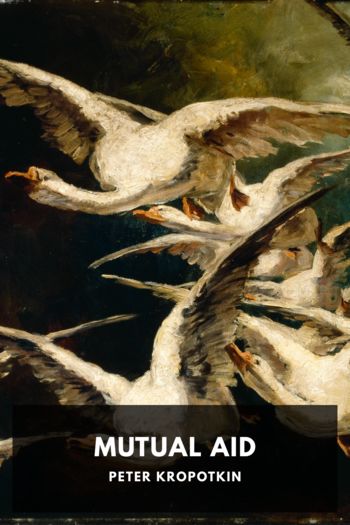Mutual Aid, Peter Kropotkin [fiction novels to read .txt] 📗

- Author: Peter Kropotkin
Book online «Mutual Aid, Peter Kropotkin [fiction novels to read .txt] 📗». Author Peter Kropotkin
Brehm, iv, 671 seq. ↩
R. Lendenfeld, in Der zoologische Garten, 1889. ↩
Syevettsoff’s Periodical Phenomena, p. 251. ↩
Seyfferlitz, quoted by Brehm, iv, 760. ↩
The Arctic Voyages of A. E. Nordenskjold, London, 1879, p. 135. See also the powerful description of the St. Kilda islands by Mr. Dixon (quoted by Seebohm), and nearly all books of Arctic travel. ↩
See Appendix III. ↩
Elliot Couës, in Bulletin U.S. Geol. Survey of Territories, iv, no. 7, pp. 556, 579, etc. Among the gulls (Larus argentatus), Polyakoff saw on a marsh in Northern Russia, that the nesting grounds of a very great number of these birds were always patrolled by one male, which warned the colony of the approach of danger. All birds rose in such case and attacked the enemy with great vigour. The females, which had five or six nests together on each knoll of the marsh, kept a certain order in leaving their nests in search of food. The fledglings, which otherwise are extremely unprotected and easily become the prey of the rapacious birds, were never left alone (“Family Habits among the Aquatic Birds,” in Proceedings of the Zool. Section of St. Petersburg Soc. of Nat., Dec. 17, 1874). ↩
Brehm Father, quoted by A. Brehm, iv, 34 seq. See also White’s Natural History of Selborne, Letter XI. ↩
Dr. Couës, Birds of Dakota and Montana, in Bulletin U.S. Survey of Territories, iv, no. 7. ↩
It has often been intimated that larger birds may occasionally transport some of the smaller birds when they cross together the Mediterranean, but the fact still remains doubtful. On the other side, it is certain that some smaller birds join the bigger ones for migration. The fact has been noticed several times, and it was recently confirmed by L. Buxbaum at Raunheim. He saw several parties of cranes which had larks flying in the midst and on both sides of their migratory columns (Der zoologische Garten, 1886, p. 133). ↩
H. Seebohm and Ch. Dixon both mention this habit. ↩
The fact is well known to every field-naturalist, and with reference to England several examples may be found in Charles Dixon’s Among the Birds in Northern Shires. The chaffinches arrive during winter in vast flocks; and about the same time, i.e. in November, come flocks of bramblings; redwings also frequent the same places “in similar large companies,” and so on (pp. 165, 166). ↩
S. W. Baker, Wild Beasts, etc., vol. i, p. 316. ↩
Tschudi, Thierleben der Alpenwelt, p. 404. ↩
Houzeau’s Études, ii, 463. ↩
For their hunting associations see Sir E. Tennant’s Natural History of Ceylon, quoted in Romanes’s Animal Intelligence, p. 432. ↩
See Emil Huter’s letter in L. Büchner’s Liebe. ↩
See Appendix IV. ↩
With regard to the viscacha it is very interesting to note that these highly-sociable little animals not only live peaceably together in each village, but that whole villages visit each other at nights. Sociability is thus extended to the whole species—not only to a given society, or to a nation, as we saw it with the ants. When the farmer destroys a viscacha-burrow, and buries the inhabitants under a heap of earth, other viscachas—we are told by Hudson—“come from a distance to dig out those that are buried alive” (Naturalist on the La Plata, p. 311). This is a widely-known fact in La Plata, verified by the author. ↩
Handbuch für Jäger und Jagdberechtigte, quoted by Brehm, ii, 223. ↩
Buffon’s Histoire Naturelle. ↩
In connection with the horses it is worthy of notice that the quagga zebra, which never comes together with the dauw zebra, nevertheless lives on excellent terms, not only with ostriches, which are very good sentries, but also with gazelles, several species of antelopes, and gnus. We thus have a case of mutual dislike between the quagga and the dauw which cannot be explained by competition for food. The fact that the quagga lives together with ruminants feeding on the same grass as itself excludes that hypothesis, and we must look for some incompatibility of character, as in the case of the hare and the rabbit. Cf., among others, Clive Phillips-Wolley’s Big Game Shooting (Badminton Library), which contains excellent illustrations of various species living together in East Africa. ↩
Our Tungus hunter, who was going to marry, and therefore was prompted by the desire of getting as many furs as he possibly could, was beating the hillsides all day long on horseback in search of deer. His efforts were not rewarded by even so much as one fallow deer killed every day; and he was an excellent hunter. ↩
According to Samuel W. Baker, elephants combine in larger groups than the “compound family.” “I have frequently observed,” he wrote, “in the portion of Ceylon known as the Park Country, the tracks of elephants in great numbers which have evidently been considerable herds that have joined together in a general retreat from a ground which they considered insecure” (Wild Beasts and Their Ways, vol. i, p. 102). ↩
Pigs, attacked by wolves, do the same





Comments (0)